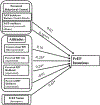Examining Factors that Impact Intentions to Use Pre-Exposure Prophylaxis Among African-American Young Adults
- PMID: 34637047
- PMCID: PMC9007631
- DOI: 10.1007/s10508-021-01974-1
Examining Factors that Impact Intentions to Use Pre-Exposure Prophylaxis Among African-American Young Adults
Abstract
Pre-exposure prophylaxis (PrEP) is a biomedical HIV prevention strategy with potential to reduce racial HIV disparities. However, African-Americans have not received the benefits of PrEP to the same extent as other groups. The theory of planned behavior (TPB) was employed to explain intentions to use PrEP among a sample of African-Americans (age 18-29) in Louisville, Kentucky. Data were derived from the Afya Project, a study examining PrEP-focused HIV prevention for African-American young adults. The sample was developed through respondent-driven sampling and participants (N = 181) completed audio computer-assisted self-interviews assessing demographics and TPB variables. Analysis of variance was used to examine relationships between demographics and PrEP intentions. Linear regressions determined associations between control beliefs, attitudes, norms, and PrEP use intentions. Confidence in using PrEP (p ≤ .0001), perceived HIV risk (p ≤ 0.05), perceived likelihood of acquiring HIV (p ≤ 0.05), and positive norms around PrEP (p ≤ 0.05) were significantly associated with PrEP use intentions. Findings can inform interventions to advance PrEP as a HIV prevention option for African-American populations at higher risk of contracting HIV.
Keywords: African-American; HIV; PrEP; Pre-exposure prophylaxis; Young adults.
© 2021. The Author(s), under exclusive licence to Springer Science+Business Media, LLC, part of Springer Nature.
Conflict of interest statement
Figures
Similar articles
-
Understanding Influences on Intention to Use Pre-exposure Prophylaxis (PrEP) Among African American Young Adults.J Racial Ethn Health Disparities. 2023 Apr;10(2):899-910. doi: 10.1007/s40615-022-01278-7. Epub 2022 Mar 15. J Racial Ethn Health Disparities. 2023. PMID: 35290648
-
Drawing from the Theory of Planned Behaviour to examine pre-exposure prophylaxis uptake intentions among heterosexuals in high HIV prevalence neighbourhoods in Philadelphia, Pennsylvania, USA: an observational study.Sex Health. 2019 Jun;16(3):218-224. doi: 10.1071/SH18081. Sex Health. 2019. PMID: 31079596
-
A Qualitative Exploration of Various Stigmas Impacting HIV Pre-Exposure Prophylaxis (PrEP) Uptake Among African American Young Adults.Fam Community Health. 2022 Oct-Dec 01;45(4):218-227. doi: 10.1097/FCH.0000000000000346. Fam Community Health. 2022. PMID: 35985022 Free PMC article.
-
PrEP Chicago: A randomized controlled peer change agent intervention to promote the adoption of pre-exposure prophylaxis for HIV prevention among young Black men who have sex with men.Clin Trials. 2018 Feb;15(1):44-52. doi: 10.1177/1740774517730012. Epub 2017 Sep 1. Clin Trials. 2018. PMID: 28862483 Free PMC article. Clinical Trial.
-
Perceptions of and intentions to adopt HIV pre-exposure prophylaxis among black men who have sex with men in Los Angeles.Int J STD AIDS. 2015 Dec;26(14):1040-8. doi: 10.1177/0956462415570159. Epub 2015 Jan 30. Int J STD AIDS. 2015. PMID: 25638214 Free PMC article.
Cited by
-
Attitudes Toward the Uptake of Combination HIV Prevention Methods Among Young Black and Latino Heterosexual Couples Living in New York City: A Qualitative Study.J Assoc Nurses AIDS Care. 2024 May-Jun 01;35(3):281-293. doi: 10.1097/JNC.0000000000000464. Epub 2024 Mar 28. J Assoc Nurses AIDS Care. 2024. PMID: 38546533 Free PMC article.
-
Applying the Transtheoretical Model and the Motivating PrEP Cascade to Better Understand the Correlates of Preexposure Prophylaxis (PrEP) Readiness Among Cisgender Black Women: A Correlational Study.J Racial Ethn Health Disparities. 2025 Jul 23. doi: 10.1007/s40615-025-02557-9. Online ahead of print. J Racial Ethn Health Disparities. 2025. PMID: 40702375
-
Understanding Influences on Intention to Use Pre-exposure Prophylaxis (PrEP) Among African American Young Adults.J Racial Ethn Health Disparities. 2023 Apr;10(2):899-910. doi: 10.1007/s40615-022-01278-7. Epub 2022 Mar 15. J Racial Ethn Health Disparities. 2023. PMID: 35290648
References
-
- Ajzen I (1985). From intentions to actions a theory of planned behavior. In Kuhl J & Beckmann J (Eds.), Action control. New York: Springer.
-
- Ajzen I, & Fishbein M (1980). Understanding attitudes and predicting social behavior. Prentice-Hall.
-
- Artiga S, & Orgera K (2020). Key facts on health and health care by race and ethnicity. Retrieved from https://www.kff.org/report-section/key-facts-on-health-and-health-care-b...
-
- Brooks RA, Allen VC Jr., Regan R, Mutchler MG, Cervantes-Tadeo R, & Lee SJ (2018). HIV/AIDS conspiracy beliefs and intention to adopt preexposure prophylaxis among black men who have sex with men in Los Angeles. International Journal of STD and AIDS, 29(4), 375–381. 10.1177/0956462417727691 - DOI - PMC - PubMed
Publication types
MeSH terms
Substances
Grants and funding
LinkOut - more resources
Full Text Sources
Medical
Miscellaneous



